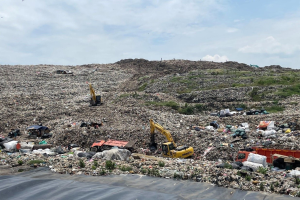Linking a global plastic pollution agreement with local realities

© fstopimages/Malte Müller

There was an enthusiastic response in March 2022 when the United Nations Environment Assembly endorsed a resolution on negotiations for a comprehensive global agreement on plastic pollution. On 24 November 2022, the EU joined the High Ambition Coalition To End Plastic Pollution. There are high expectations on all sides that the worldwide problem of plastic pollution can be brought under control. As the first round of high-level negotiations on the agreement commenced at the end of November 2022, our travels through South-East Asia confronted us with local realities.
We have chosen three examples (A, B and C below) which show the diverse local challenges arising worldwide, how progress can be achieved at this level and why it must link in with the debates during the negotiations on a global plastic pollution agreement.
Our visits received financial support from the Deutsche Gesellschaft für Internationale Zusammenarbeit (GIZ) GmbH under the Sustainable Solutions for Reducing Plastic Packaging in Asia project, which is funded by the German Federal Ministry for the Environment, Nature Conservation, Nuclear Safety and Consumer Protection (BMUV) via the Export Initiative for Environmental Technologies
A: In Indonesia, “reusables” are known as “returnables” and are promoted as a lifestyle choice. Without taxes and bans on single-use packaging or positive monetary incentives for multi-use solutions, however, it will be impossible to reduce plastic waste.
Reuse is an important strategy for avoiding plastic waste. Although single-use packaging is found littering the streets in South-East Asia every day, some local markets offer reusable plates and bowls and operate central collection points and dishwashing facilities.
However, in Indonesia, Malaysia and Thailand, (policy) measures to promote multi-use solutions are met with considerable scepticism, with arguments focusing on the absence of health and hygiene standards and lack of dishwashing facilities and/or collection and traceability logistics, not to mention public indifference. Nevertheless, measures to promote reuse are needed to achieve the Indonesian government’s target of reducing plastic waste by 70% by 2027.
The small-scale providers of reuse solutions generally market their products as “returnables” rather than “reusables” in order to avoid giving the impression that cleanliness may be an issue. The negative consequences of utilising single-use plastics that contain chemicals such as softeners or Bisphenol A (BPA) are not discussed.
Instead of investing in measures to improve the process, such as a reverse logistics infrastructure or central dishwashing stations for reusables, the preferred option is to channel financial resources into “modern technologies” and large-scale (self-contained) facilities. This is the prevailing attitude in international cooperation as well. We opted to frame reuse systems as “state-of-the-art”, e.g. with the use of digital apps for traceability and accounting procedures in order to generate interest from financial institutions.
Yet the reduction target for single-use packaging is not achievable.
Alongside a clear commitment to plastic prevention and reuse from the agreement’s negotiators, the following actions are required:
-
high taxes on single-use plastics,
-
negative incentives (= bans) on resource-intensive single-use plastic products, and
-
meaningful positive incentives, large-scale funding programmes and subsidies for circular multi-use business models
… as previously described in this blog.
Currently, the reuse companies’ target market is young, urban and small in scale. National governments and local decision-makers across the world must take action to make reuse solutions fit for the mass market
B: Upcycling, downcycling or recycling? The need for a clear definition and broad consensus
It is both fascinating and shocking to see how the terms “upcycling”, “downcycling” and “recycling” are open to interpretation: for example, the use of recycled PET in textiles is lauded as upcycling. According to an information board in a material recovery facility (MRF): “recycling involves destruction of waste in order to create something new”. In other words, the difference between recycling and upcycling is that in the case of recycling, the waste product or material must be broken down in order to manufacture a new item, whereas upcycling means creating a new product from the waste itself.
And there is even less awareness of advanced recycling. This is a phrase often used by industry to describe chemical recycling – an umbrella term for various processes, such as pyrolysis, none of which is currently available on a large scale. The research conducted by our colleagues shows that a zero-emissions economy based on chemical recycling is almost impossible to achieve. They conclude that wherever possible, mechanical recycling should take precedence over pyrolysis.
A strategy to promote mechanical recycling at scale in order to increase the proportion of recycled material in packaging should be high on the political agenda for the negotiators of the plastic pollution agreement. So in which cases and under which circumstances should chemical recycling be given a role in the circular economy for plastics? This is currently the subject of intense debate in the EU. In South-East Asia, however, the decision in favour of chemical recycling has apparently already been taken – despite its substantial energy demand, poorer environmental performance compared with mechanical recycling, and high costs.
Here, there is a considerable need for independent, knowledge-based advice, not least because investing heavily in technologies with dubious environmental benefits would lead to undesirable lock-in effects and water down plastic reduction efforts. This means that before any investment decisions are taken, the environmental benefits of potential measures must be compared. Support should be provided for measures with the greatest potential to ease the burden on the environment. Otherwise, if investment decisions are taken without these analyses, less funding is likely to be available to support measures offering substantial environmental benefits.
This rather patchy background knowledge is the starting point for conversations at the workshops in Indonesia and Thailand on recycled content and recycling targets – without any shared definitions or discussion of priorities. This lack of clarity can even be found in policy goals: in Thailand, for example, the national Roadmap for Plastic Waste Management 2018-2030 sets a 100% target for plastics recycling by 2027 but does not specify which type of recycling is meant.
A consensus therefore needs to be reached and definitions established when policy-makers come together to negotiate the plastic pollution agreement. And once this high-level consensus is achieved, a great deal of effort will be required to ensure that the discussions during these negotiations link in with local realities
C: The wrong focus: waste incineration and landfill must be reduced in future.

Standing at the foot of South-East Asia’s largest landfill in Jakarta, we have to ask ourselves why, as a society, we are not doing much more to minimise and prevent waste. The mountains of garbage at this site are 50 metres high and the heat is intense. There are people here as well: waste pickers who scurry up and down the heaps of waste like tiny ants in search of precious finds. They work 24 hours a day, seven days a week. The sheer volume of waste obscures the potential for anything but short-term solutions: posters in the buildings at the site call for action to extend the lifetimes of the landfills, and incineration is promoted as a way of minimising waste.
A better option would be to extend product lifetimes and keep resources in circulation for as long as possible. Although Indonesia plans to reduce its waste incineration, growing quantities of plastic waste are being burned in cement works as refuse-derived fuel (RDF). Under the present circumstances, this undoubtedly makes sense as a second-best option, for the South-East Asian countries are predicted to experience a construction boom in the coming decades. Demand for cement is correspondingly high and RDF can be used here as a replacement for coal: it is a better option than landfill or incineration, which tends to have poor efficiency rates. In the medium term, however, action needs to be taken to promote mechanical recycling or, better still, to reduce plastic waste so that landfills and incinerators become redundant as far as possible.
When it comes to waste prevention, local authorities can potentially achieve a great deal by introducing bans, establishing segregated-waste collection facilities, ensuring that (major) events are plastic-free, switching to plastic-free procurement, etc. There is scope to fund these measures by introducing waste charges for households and businesses and implementing a mandatory extended producer responsibility mechanism.
However, national governments should not leave the issue solely to the local authorities. Many of the measures require decision-making at the national level. Examples are fiscal policies such as taxes and charges on single-use plastics, the development of guidelines and standards for reusable products and associated processes, and the setting of national targets for reusables in the marketplace.
Progress must be achieved at all levels – local, national and via the global plastic pollution agreement – so that in future, fewer new landfill sites are opened, less waste is incinerated and working conditions in the waste sector are improved. All these measures are necessary to manage the problem of plastic waste and its impacts.
We sum up:
Something must be done: this was recognised by the international community in March 2022 with its decision to negotiate a global plastic pollution agreement. It was also recognised by everyone we met and spoke with on our journey. What can be done to reach the targets that will be negotiated and, in all likelihood, ratified by national governments? There are many questions to be answered here.
Our partner organisations asked us for support and guidance on a number of issues, as well as assistance with formulating arguments. For example, we were asked to give our technical assessment of a proposal from operators of chemical recycling facilities, who were keen to access all the plastic waste from the hotel industry as input for their processes. We were also asked which recycling options should be considered viable. And a further example: overseas companies are putting pressure on governments to recognise a (still) questionable process – involving biodegradability of plastic in the natural environment – in their standardisation systems, even though the process is not currently viable without designated technical composting facilities. As for one of the key questions – is reuse suitable for upscaling? – our partners need scientific and technical arguments here.
Against this background, our political partners welcome our policy proposals for waste prevention, which were developed on the basis of independent scientific analyses. For example, we outlined various proposals on the basis on a detailed waste hierarchy in a Policy Brief on SUP and Packaging Waste Prevention with our Thai partners. Thailand has incorporated some of the measures from this Policy Brief into its Waste Management Action Plan Phase II (2022-2027).
This shows how important it is to recognise and discuss local challenges. The international agreement which is undoubtedly required must also reach the local and national levels and achieve visible progress with substantial environmental benefits. Technical expertise must be shared between the various levels, and the definitions, debates and decisions, as well as the outcomes at all levels, must be properly explained. Studies are all well and good – but we must do more, and that includes analysis, advice and networking.
This is exactly the contribution that the Oeko-Institut can make as an independent provider of science-based policy advice. We want to support our partners by sharing our experience, our aim being to:
-
make policy-makers aware of the challenges,
-
devise specific recommendations for all levels of governance,
-
identify key stakeholders and promote networking among them.
The objective: there should not be question marks over how to implement policy goals at the local level. Instead, implementation must be addressed through practical action.
Clara Löw and Siddharth Prakash conduct research on sustainable materials, products and consumption patterns in the Sustainable Products and Material Flows Division of the Oeko-Institut in Freiburg.
Further information
Study "Recycled content in plastic material with focus on PET, HDPE, LDPE, PP"
As part of the project, background papers were produced on